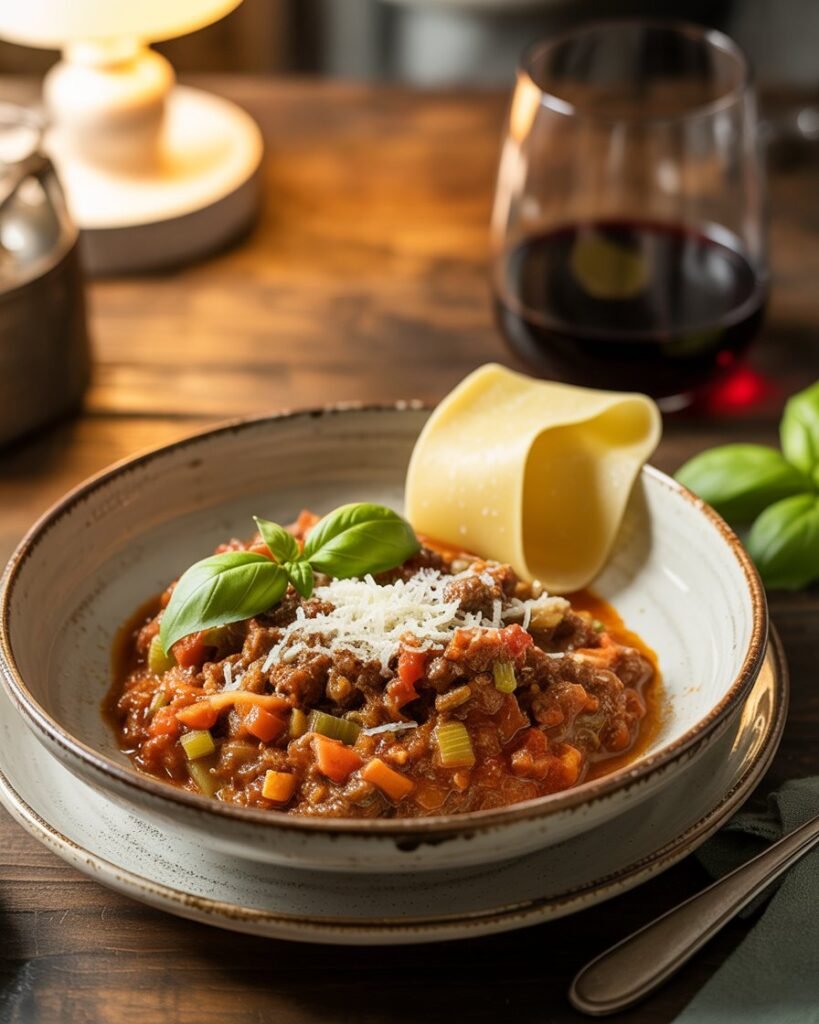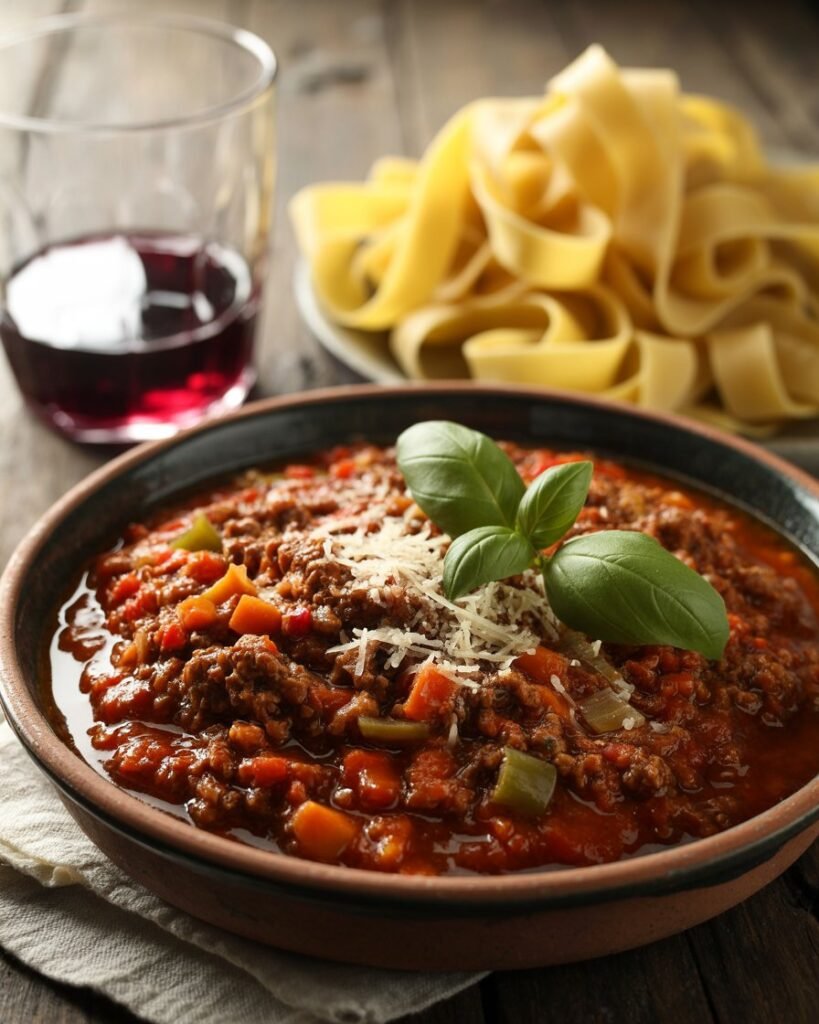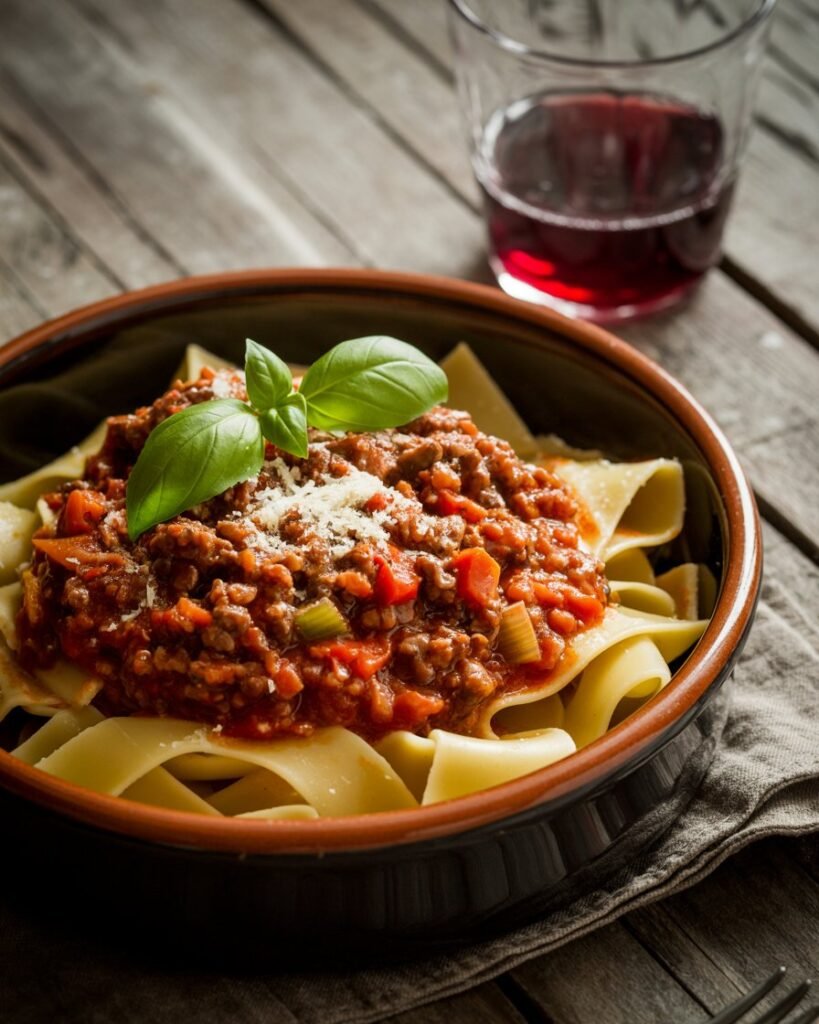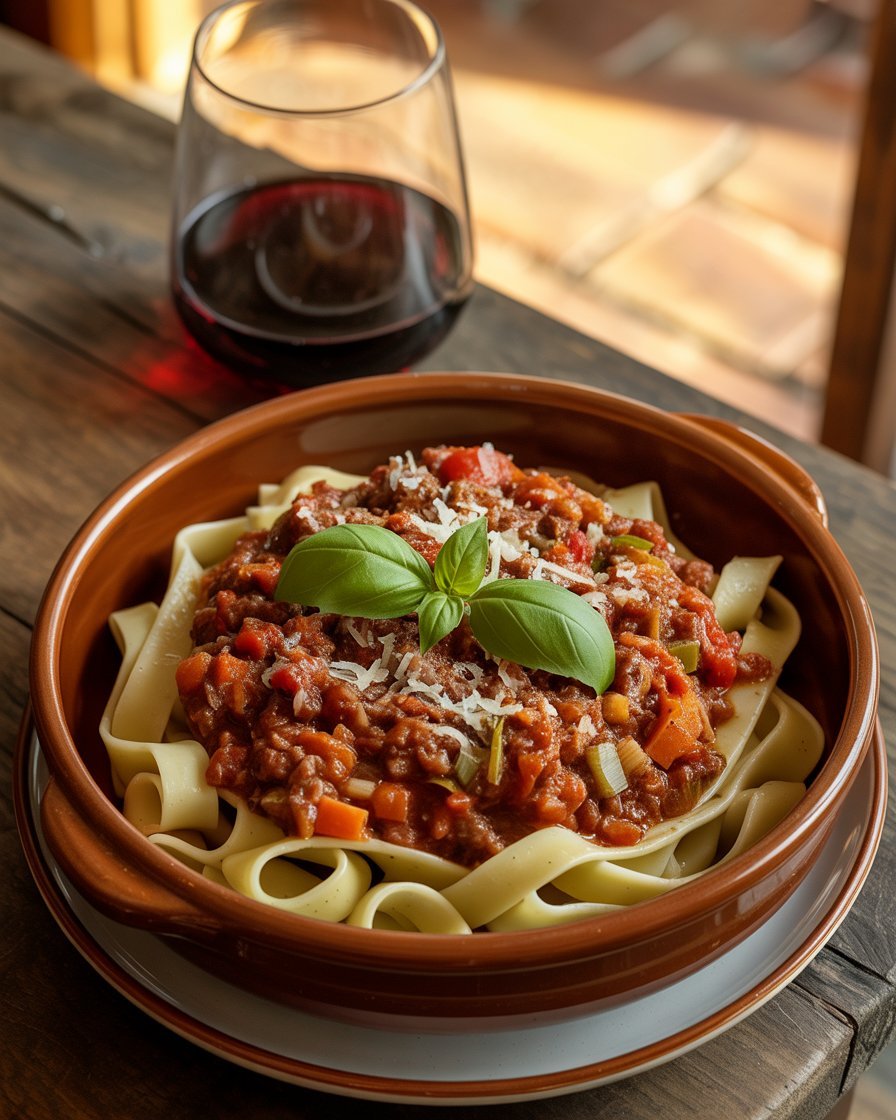A Comforting Dish for Every Occasion
Slow-cooked beef ragu Recipe is a timeless Italian dish that brings together tender, fall-apart beef , a rich and savory tomato-based sauce , and the aromatic depth of herbs and vegetables . This hearty meal is perfect for dinner , but its versatility also makes it an excellent option for lunch or even breakfast when reheated with a fried egg on top . With just 10 minutes of preparation time , this recipe allows you to enjoy a slow-cooked, restaurant-quality dish without spending hours in the kitchen.
The beauty of beef ragu lies in its simplicity—made with economical ingredients like beef chuck steak, onions, carrots, celery, garlic, red wine, tomato paste, passata, and beef stock , it transforms humble components into something truly special. The long, slow cooking process ensures that the meat becomes incredibly tender while infusing the sauce with deep, complex flavors.
This article will guide you through everything you need to know about making the perfect slow-cooked beef ragu , including a detailed list of ingredients , step-by-step instructions , nutritional benefits , serving suggestions , and answers to frequently asked questions. Whether you’re a beginner cook or looking to refine your technique, this recipe will become a staple in your household.
Ingredients for Slow-Cooked Beef Ragu recipe
Creating a rich and flavorful beef ragu requires a combination of simple yet essential ingredients that work together to build layers of taste and texture. Below is a detailed breakdown of what you’ll need:
Base Ingredients
| Extra-Virgin Olive Oil | 2 tablespoons | Adds richness and helps sauté vegetables and brown the meat |
| Brown Onions | 2 large, finely diced | Provides sweetness and depth to the base of the sauce |
| Carrots | 2 large, finely diced | Adds natural sweetness and enhances the overall flavor profile |
| Celery Stalks | 2, finely diced | Contributes a savory, earthy note and balances the sweetness from carrots and onions |
| Garlic Cloves | 2, roughly chopped | Enhances aroma and adds a subtle pungency to the sauce |
Main Protein
| Beef Chuck Steak (Braising/Casserole Cut) | 800g–1kg (1lb 12oz–2lb 3oz), cut into 2cm cubes | Becomes tender and falls apart beautifully after slow cooking; can be substituted with other cuts like brisket or short ribs |
Liquid and Flavor Enhancers
| Dry Red Wine | ½ cup (125ml) | Deglazes the pan and adds depth and acidity to the sauce |
| Tomato Paste | ½ cup (125g) | Concentrated flavor that builds the base of the sauce |
| Tomato Passata | 700ml (23.5 fl oz) | Smooth, uncooked tomato puree that gives the sauce body and richness |
| Beef Stock | 2 cups (500ml) | Adds umami and helps keep the meat moist during cooking |
| Salt | 1 teaspoon | Balances flavors and enhances overall taste |
| Cracked Black Pepper | ½ teaspoon | Adds warmth and complexity |
| Dried Thyme | 1 teaspoon | Brings an earthy, herbal note to the sauce |
| Bay Leaves | 2 leaves | Infuses the ragu with a subtle floral and herbal undertone |
Serving Suggestions
| Pasta (Rigatoni recommended) | To serve | Classic pairing that holds the sauce well |
| Freshly Grated Parmesan | To serve | Adds a salty, nutty finish to the dish |
With these high-quality ingredients, you’ll be able to create a slow-cooked beef ragu that is both flavorful and satisfying . Now that you have everything ready, let’s move on to the step-by-step instructions.

Step-by-Step Instructions for Making Slow-Cooked Beef Ragu Recipe
Creating a delicious slow-cooked beef ragu is a straightforward process that yields rich, deep flavors thanks to the long simmering time. Follow these clear and concise steps to ensure success every time.
Step 1: Sauté the Aromatics
- In a deep, heavy-based pan with a lid , heat 2 tablespoons of extra-virgin olive oil over medium-high heat .
- Add 2 finely diced brown onions, 2 finely diced carrots, 2 finely diced celery stalks, and 2 roughly chopped garlic cloves .
- Cook, stirring occasionally, for 3–5 minutes until the vegetables begin to soften and release their aromas.
Tip: Be sure not to rush this step—allowing the vegetables to sweat and soften properly builds the foundation of the sauce.
Step 2: Brown the Beef
- Increase the heat to high and add 800g–1kg of cubed beef chuck steak to the pan.
- Cook, stirring occasionally, for 2–3 minutes until the beef is seared on all sides . This step helps develop a rich color and deep flavor through the Maillard reaction.
Note: You don’t need to fully cook the beef at this stage—just enough to get a good sear.
Step 3: Deglaze and Build the Sauce
- Pour in ½ cup of dry red wine to deglaze the pan, scraping up any browned bits from the bottom of the pot.
- Stir in ½ cup of tomato paste , allowing it to cook for 1–2 minutes to deepen its flavor.
- Add 700ml of tomato passata, 2 cups of beef stock, 1 teaspoon of salt, ½ teaspoon of cracked black pepper, 1 teaspoon of dried thyme, and 2 bay leaves .
- Stir well to combine all the ingredients and bring the mixture to a gentle simmer .
Step 4: Simmer the Ragu Recipe
- Once the mixture reaches a simmer, reduce the heat to the lowest setting .
- Cover the pan with a lid and let the ragu cook slowly for 2.5 hours , or until the beef is tender enough to be easily shredded with two forks .
Important Tip: Ensure that the sauce is gently bubbling throughout the cooking process. If it stops simmering, increase the heat slightly to maintain a gentle movement in the liquid.
Step 5: Shred the Beef and Serve
- After 2.5 hours, remove the lid and use two forks to shred the beef directly in the sauce.
- Taste and adjust seasoning if needed—add more salt, pepper, or herbs to enhance the flavor.
- Serve hot with rigatoni pasta or your preferred pasta shape, and top generously with freshly grated parmesan cheese .
Optional: For an even richer sauce, allow the ragu to sit overnight in the refrigerator—the flavors will intensify and meld together beautifully.
By following these steps carefully, you’ll end up with a perfectly balanced, deeply flavorful slow-cooked beef ragu that’s sure to impress.
Nutritional Information and Benefits of Slow-Cooked Beef Ragu Recipe
Slow-cooked beef ragu is not only a comforting and flavorful dish but also a nutrient-dense meal packed with protein, fiber, vitamins, and minerals . This hearty dish provides sustained energy and supports muscle growth, immune function, and digestive health. Below is a detailed breakdown of the nutritional content per serving based on the original recipe (4 servings):
Nutrition Facts (Per Serving)
| Calories | 569 kcal | – |
| Total Fat | 18.8g | 24% |
| Saturated Fat | 4.3g | 22% |
| Cholesterol | 118.9mg | 40% |
| Sodium | 1387.3mg | 60% |
| Total Carbohydrate | 51.1g | 19% |
| Dietary Fiber | 8.6g | 31% |
| Sugars | 18.3g | – |
| Protein | 50.2g | 100% |
| Vitamin A | 40% | – |
| Vitamin C | 38% | – |
| Magnesium | 30% | – |
| Potassium | 42% | – |
| Riboflavin (B2) | 60% | – |
Key Nutritional Benefits
- High in Protein:
With 50 grams of protein per serving , this dish is an excellent source of complete protein , supporting muscle repair, immune function, and satiety . The beef provides all nine essential amino acids , making it a valuable addition to a balanced diet. - Rich in Iron and B Vitamins:
Beef is naturally high in heme iron , which is more easily absorbed by the body than non-heme iron found in plant sources. It also contains vitamin B12, riboflavin (B2), and niacin (B3) , which are crucial for energy production, brain function, and red blood cell formation . - Good Source of Dietary Fiber:
The inclusion of onions, carrots, and celery contributes dietary fiber , promoting healthy digestion and maintaining stable blood sugar levels. Each serving provides 8.6 grams of fiber , meeting over 30% of the daily recommended intake . - Packed with Antioxidants and Vitamins:
Tomatoes are rich in lycopene, vitamin C, and potassium , which support heart health and protect against oxidative stress. Additionally, garlic and herbs like thyme contribute anti-inflammatory and antimicrobial properties , enhancing immune function. - Balanced Macronutrient Profile:
This dish offers a well-rounded balance of protein, carbohydrates, and fats , making it suitable for various dietary needs. It is particularly beneficial for individuals seeking sustained energy, muscle recovery, or post-workout nutrition . - Gluten-Free Option Available:
While traditional pasta contains gluten, this dish can easily be adapted for those following a gluten-free diet by using gluten-free pasta varieties made from rice, corn, quinoa, or legumes. - Customizable for Additional Nutrients:
You can further boost the nutritional profile by adding steamed vegetables (like spinach, zucchini, or mushrooms) directly into the ragu or serving it alongside a fresh green salad for added vitamins and antioxidants.
By incorporating nutrient-dense ingredients like beef, vegetables, and tomatoes , this slow-cooked beef ragu delivers a well-balanced and satisfying meal that supports overall health and wellness.

Serving Suggestions for Slow-Cooked Beef Ragu Recipe
Slow-cooked beef ragu is a versatile dish that pairs beautifully with a variety of sides, making it suitable for breakfast, lunch, or dinner . Whether you’re enjoying it as a comforting weeknight meal , a meal-prepped lunch , or a crowd-pleasing dinner , there are countless ways to enhance your experience with complementary flavors and textures.
Perfect Pairings for Every Meal
| Pasta | Rigatoni, pappardelle, tagliatelle, fettuccine, spaghetti |
| Bread | Crusty sourdough, garlic bread, rosemary focaccia, toasted baguette slices |
| Vegetables | Roasted root vegetables, steamed broccoli, grilled zucchini, sautéed mushrooms |
| Proteins | Grilled chicken, pork chops, Italian sausage, lentil loaf |
| Salads | Arugula salad with lemon vinaigrette, kale Caesar salad, caprese salad, roasted beet salad |
| Breakfast Items | Fried eggs, poached eggs, avocado toast, hash browns |
| Snacks & Appetizers | Stuffed mushrooms, bruschetta, stuffed bell peppers, garlic crostini |
Creative Ways to Use Leftover Beef Ragu Recipe
Don’t let leftover beef ragu go to waste—there are plenty of creative ways to repurpose it into new and exciting dishes. Here are some inventive ideas:
| Beef Ragu Lasagna | Layer leftover ragu with lasagna noodles, béchamel or ricotta, and mozzarella for a hearty baked dish. |
| Beef Ragu Stuffed Peppers | Fill bell peppers with ragu and rice, then bake until tender for a nutritious and flavorful meal. |
| Beef Ragu Quesadillas | Spread ragu between two tortillas, add melted cheese, and grill until crispy for a fusion twist. |
| Beef Ragu Shepherd’s Pie | Top cooled ragu with mashed potatoes and bake until golden for a comforting one-dish meal. |
| Beef Ragu Burgers | Mix cooled ragu with breadcrumbs and finely chopped veggies, form into patties, and pan-fry for a unique burger option. |
| Beef Ragu Casserole | Combine ragu with cooked pasta, beans, or lentils and bake for a hearty, one-dish meal. |
| Frozen Portions for Quick Meals | Freeze individual portions of ragu for a convenient, ready-to-reheat meal. Simply thaw and reheat in the microwave or oven for a quick lunch or dinner option. |
Ideal Times to Enjoy Slow-Cooked Beef Ragu Recipe
Whether you’re having a casual weeknight dinner or hosting a special gathering, beef ragu is a welcome addition to any table. Here are some of the best times to serve it:
- Breakfast: Pair with scrambled eggs, avocado toast, or a veggie-packed omelet for a hearty morning meal.
- Lunch: Serve alongside a fresh salad or soup for a satisfying midday meal. It also works well as a packed lunch for school or work.
- Dinner: Offer ragu as a main course or side dish with roasted vegetables, grilled meats, or casseroles for a comforting evening meal.
- Holiday Meals: This dish is a perfect addition to Thanksgiving, Christmas, or Easter feasts, complementing traditional mains like roast beef or ham.
- Brunch: Incorporate ragu into your weekend brunch spread with options like breakfast sliders, stuffed pastries, or loaded baked potatoes.
- Picnics and Potlucks: Pack warm ragu in a thermos or serve it chilled with dips and crackers for an easy and crowd-pleasing picnic or potluck option.
With so many ways to enjoy and repurpose beef ragu, it truly is a versatile and beloved staple in any kitchen.
Tips and Tricks for Perfecting Slow-Cooked Beef Ragu Recipe
Creating the perfect slow-cooked beef ragu requires more than just following a recipe—it involves understanding the ingredients, mastering techniques, and avoiding common pitfalls. Whether you’re new to slow cooking or looking to refine your skills, these expert tips will help you achieve consistently delicious results every time.
1. Choose the Right Cut of Beef
Beef chuck steak is ideal for ragu due to its marbling and connective tissue , which break down during slow cooking to yield tender, fall-apart meat . Other suitable cuts include brisket, short ribs, and shank . Avoid lean cuts like sirloin or tenderloin, as they can become tough and dry when cooked for extended periods.
2. Don’t Skip the Sear
Searing the beef before slow cooking is crucial for developing deep, caramelized flavors through the Maillard reaction. Take the time to brown the meat in batches, ensuring each piece gets a good sear. Overcrowding the pan prevents proper browning, so work in small batches if necessary.
3. Use a Heavy-Based Pot for Even Cooking
A heavy-bottomed Dutch oven or thick-walled pot distributes heat evenly and retains warmth, preventing hot spots that could lead to burning or uneven cooking. This is especially important during the long simmering process.
4. Deglaze with Red Wine for Depth of Flavor
Deglazing the pan with dry red wine after browning the beef lifts the browned bits from the bottom of the pot, infusing the sauce with rich, complex flavors . If you prefer not to use alcohol, substitute with balsamic vinegar or additional beef stock .
5. Balance Acidity with Tomato Paste and Passata
Tomato paste adds intensity and depth , while passata contributes smoothness and body to the sauce. Adjust the ratio depending on how robust you want the final flavor to be. If the sauce tastes too acidic, a pinch of brown sugar or honey can help balance it out.
6. Cook Low and Slow for Maximum Tenderness
Patience is key when making ragu. Cooking the beef over low heat for at least 2.5 hours allows the collagen in the meat to break down, resulting in melt-in-your-mouth tenderness . If the beef isn’t quite falling apart after the initial cooking time, continue simmering in 30-minute increments until desired texture is achieved.
7. Skim Impurities for a Clean-Tasting Sauce
As the ragu simmers, foam may rise to the surface. Use a ladle or spoon to skim off impurities and excess fat , ensuring a clear, refined sauce with a clean flavor profile.
8. Let the Ragu Rest Overnight for Enhanced Flavor
One of the secrets to a great ragu is resting it overnight in the refrigerator . This allows the flavors to meld together, resulting in a more cohesive and intensely flavored sauce . Reheat gently before serving.
9. Adjust Seasoning Before Serving
Taste the ragu before serving and adjust the salt, pepper, or herbs as needed. Sometimes the flavors mellow during cooking, so a final seasoning adjustment ensures the best possible taste.
10. Store and Freeze for Future Meals
Leftover ragu stores exceptionally well and can be refrigerated for up to 3 days or frozen for up to 3 months . Store it in airtight containers or freezer bags , and thaw overnight in the refrigerator before reheating. Reheat gently on the stove or in the microwave, adding a splash of water or broth if needed to loosen the sauce.
By applying these expert tips, you can elevate your slow-cooked beef ragu from good to exceptional, ensuring a rich, flavorful, and satisfying dish every time.

Frequently Asked Questions (FAQs) About Slow-Cooked Beef Ragu Recipe
Whether you’re preparing this dish for the first time or looking to refine your technique, it’s natural to have questions about ingredient substitutions, storage, and customization. Below are some of the most commonly asked questions about slow-cooked beef ragu, along with helpful answers to ensure a successful and enjoyable meal.
1. Can I Make Beef Ragu Recipe in a Slow Cooker?
Yes, beef ragu adapts beautifully to a slow cooker . Simply follow the same steps for sautéing the vegetables and browning the beef, then transfer everything to the slow cooker. Cook on low for 6–8 hours or on high for 3–4 hours , adjusting the liquid amount if needed. The result is a perfectly tender and flavorful ragu with minimal hands-on effort.
2. What Are Some Good Substitutes for Beef Chuck?
If beef chuck is unavailable, consider using brisket, short ribs, or shank —all of which offer similar marbling and connective tissue that break down beautifully during slow cooking. For a plant-based alternative , try using jackfruit, mushrooms, or lentils for a vegetarian version of the dish.
3. Can I Make This Ragu Recipe Gluten-Free?
Yes, beef ragu is naturally gluten-free, but traditional pasta is not. To make the entire meal gluten-free, simply use gluten-free pasta such as brown rice, corn, quinoa, or legume-based pasta. These alternatives hold up well in the rich sauce and provide a similar texture to regular pasta.
4. How Can I Make the Sauce Thicker or More Intensive?
If your ragu turns out too thin, you can simmer it uncovered for the last 30 minutes of cooking to reduce and thicken the sauce. Alternatively, mix a small amount of cornstarch or flour with cold water and stir it into the sauce while cooking to achieve a thicker consistency.
5. Is It Possible to Freeze Beef Ragu Recipe?
Absolutely! Beef ragu freezes exceptionally well, making it a great meal-prep option . Allow the ragu to cool completely before transferring it to freezer-safe containers or ziplock bags . It can be stored in the freezer for up to 3 months . When ready to use, thaw it in the refrigerator overnight and reheat gently on the stovetop or in the microwave.
6. Can I Make Beef Ragu Recipe Ahead of Time?
Yes, beef ragu actually tastes better the next day as the flavors have had time to meld together. Prepare the ragu ahead of time and store it in the refrigerator for up to 3 days . When ready to serve, gently reheat it on the stovetop, adding a splash of water or broth if needed to loosen the sauce.
7. Why Did My Beef Turn Out Tough?
There are several reasons why beef might remain tough even after long cooking:
- Cooking Temperature Too High: Cooking at too high a temperature can cause the meat to become chewy rather than tender. Always cook ragu over low heat.
- Insufficient Cooking Time: Depending on the cut of beef, you may need to cook it longer than the recommended 2.5 hours. Continue cooking in 30-minute intervals until the beef easily shreds with a fork.
- Using Lean Cuts of Meat: Lean cuts like sirloin or tenderloin lack the connective tissue that breaks down during slow cooking, resulting in a drier texture. Stick with tougher, fattier cuts like chuck or brisket for optimal tenderness.
8. Can I Add Vegetables or Beans to the Ragu?
Yes, beef ragu is highly customizable. Feel free to add carrots, zucchini, bell peppers, eggplant, or mushrooms directly into the pot for added nutrition and flavor. For a heartier version, incorporate canned beans like cannellini or kidney beans during the last hour of cooking.
9. What Can I Do If My Ragu Turns Out Too Bitter or Acidic?
Sometimes, the acidity from the tomatoes can overpower the dish. To balance the flavor:
- Add a pinch of sugar or honey to counteract the acidity.
- Stir in a splash of cream or butter to mellow out the tanginess.
- Letting the ragu rest overnight often softens the acidity and enhances the overall flavor.
10. Can I Make Beef Ragu in an Instant Pot or Pressure Cooker?
Yes, you can make beef ragu in an Instant Pot or pressure cooker for faster results. Here’s how:
- Use the Sauté function to brown the beef and cook the vegetables.
- Deglaze with red wine and add the remaining ingredients.
- Secure the lid and set the pressure cooker to Manual or Pressure Cook mode for 30–40 minutes , followed by a natural pressure release .
- Shred the beef and simmer on sauté mode for 10–15 minutes to thicken the sauce if needed.
By addressing these common concerns, you can confidently prepare and customize your slow-cooked beef ragu to suit your preferences and dietary needs.
Conclusion: Mastering the Art of Slow-Cooked Beef Ragu Recipe
Slow-cooked beef ragu is more than just a meal—it’s a celebration of patience, technique, and the transformative power of time in the kitchen. With its rich, savory sauce , fall-apart beef , and depth of flavor , this dish stands as a testament to the beauty of slow cooking. Whether you’re preparing it for a family dinner, meal prepping for the week, or entertaining guests, mastering this classic Italian dish opens the door to endless culinary possibilities.
From selecting the right cut of beef to understanding the nuances of layering flavors and controlling cooking temperatures, each step plays a crucial role in achieving the perfect result. By following the detailed instructions, applying expert tips, and learning from common mistakes, you can consistently produce ragu that rivals those found in the finest Italian kitchens.
Beyond its delicious taste, beef ragu offers significant nutritional benefits. Rich in protein, iron, B vitamins, and fiber , it supports overall health and wellness. Its adaptability also means it can be customized to fit various dietary preferences, from gluten-free versions to vegetarian adaptations , ensuring that everyone can enjoy a comforting bowl of this beloved dish.
Moreover, the ability to prepare the ragu ahead of time, freeze leftovers, and reheat effortlessly makes it a valuable addition to any home cook’s repertoire. Whether you’re a seasoned chef or a beginner, beef ragu offers something for everyone.
Ultimately, mastering the art of slow-cooked beef ragu is about more than just following a recipe—it’s about embracing the joy of cooking, experimenting with flavors, and sharing the warmth of homemade meals with loved ones. With practice and patience, you’ll find yourself reaching for this recipe time and time again, knowing that every batch brings you closer to perfection.

